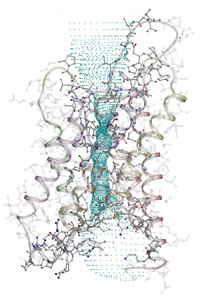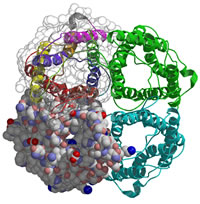|
|
 |
BERKELEY, CA — The structure of one of the basic
members of the cell-membrane water-channel family, a protein called aquaporin
1 (AQP1), has been determined to a resolution of 2.2 angstroms -- 22 hundred-billionths
of a meter. The structure reveals the elegantly simple means by which
AQP1 can transport water through the cell membrane at a high rate while
effectively blocking everything else -- even individual protons, the nuclei
of hydrogen atoms.
 |
 |
| |
A side view of a pore (blue dots) in the water-channel
protein AQP1, which pierces the cell membrane. Cell exterior is at
top, interior at bottom. The pore is about 2.8 angstroms across at
its narrowest.
|
Biophysicist Bing Jap led a team from Lawrence Berkeley National Laboratory's
Life Sciences Division in the difficult and painstaking crystallization
of this membrane protein, whose crystal structure was then solved from
x-ray diffraction at Beamline 5.0.2 of Berkeley Lab's Advanced Light Source.
Their report appears in Nature, December 20, 2001.
In almost all cells, from bacteria to those found in a variety of human
tissues, pores embedded in cell membranes transport water rapidly into
or out of the cell. Body temperature, digestion, reproduction, fluid pressure
in the eye, and water conservation in the kidney are only a few of the
processes in humans that depend on the proper functioning of cellular
water channels.
"Membrane proteins are a very large class of proteins; some 30 percent
of the genes in the human genome code for them. But they are notoriously
difficult to crystallize, and only a few structures have been solved at
very high resolution," Jap says.
Electron-microscope crystallography can use very small crystals, and the
structure of AQP1 had previously been solved to a resolution of about
4 angstoms using this technique. At this resolution it is impossible to
see individual water molecules, however, so vital features were left out
or mistakenly characterized.
Jap and his colleagues crystallized AQP1, closely similar to that in human
and other cells, from bovine red blood cells. They liberated enough protein
from "gallons of blood" to make .2-millimeter crystals, suitable
for x-ray crystallography at the Advanced Light Source.
"AQP1 is interesting because it is so specific for water" says
Jap. "The key question was how it achieves this specificity. Theorists
had come up with lots of ideas, but before we saw the structure in high-resolution,
nobody knew how it was accomplished."
Architecturally, AQP1 is an assembly of four units, each with three major
structural features: each has an entrance, or "vestibule," on
the outside of the cell envelope, connected to a similar vestibule inside
the cell by a long, narrow pore.
 |
 |
| |
From outside the cell, the four units of the water-channel
protein AQP1 are visible, each with a pore that penetrates the cell
membrane.
|
"The secret of AQP1's specificity is two-fold: it selects for size
and for chemical nature," Jap says. "There is a very narrow
constriction in the pore, which admits no molecule bigger than water.
To keep out molecules smaller than water there is also a chemical filter,
formed by the specific orientation and distribution of the amino acid
residues lining the pore."
Molecules attempting to enter the channel are bound to water molecules
that are stripped away in the pore; charged species are therefore left
with net electrical charge. "The filter strongly rejects charged
molecules or ions, even as small as single protons," Jap explains.
The unique distribution of amino acid residues along the pore wall also
accounts for the channel's ability to move water quickly, explains Peter
Walian, a member of the team that solved the structure. "It's a schizophrenic
environment, half hydrophilic and half hydrophobic" -- that is, half
water-loving and half water-fearing. "Water molecules readily get
in because of the hydrophilic sites, but the hydrophobic regions prevent
them from binding too frequently."
Thus water and only water flows freely in and out of the cell through
AQP1's pores, the direction of flow depending only on changing relative
pressure inside and outside the cell. "It's a beautiful mechanism,"
Walian remarks. "It's remarkable that nobody thought of it before
now."
"This is what structural biology is for," Jap says. "It
shows us how extremely simple nature's solutions can be."
"Structural basis of water specific transport through AQP1 water
channel," by Haixin Sui, Bong-Gyoon Han, John K. Lee, Peter Walian,
and Bing K. Jap, appears in the 20 December 2001 issue of the journal
Nature.
The Berkeley Lab is a U.S. Department of Energy national laboratory located
in Berkeley, California. It conducts unclassified scientific research
and is managed by the University of California.
|

